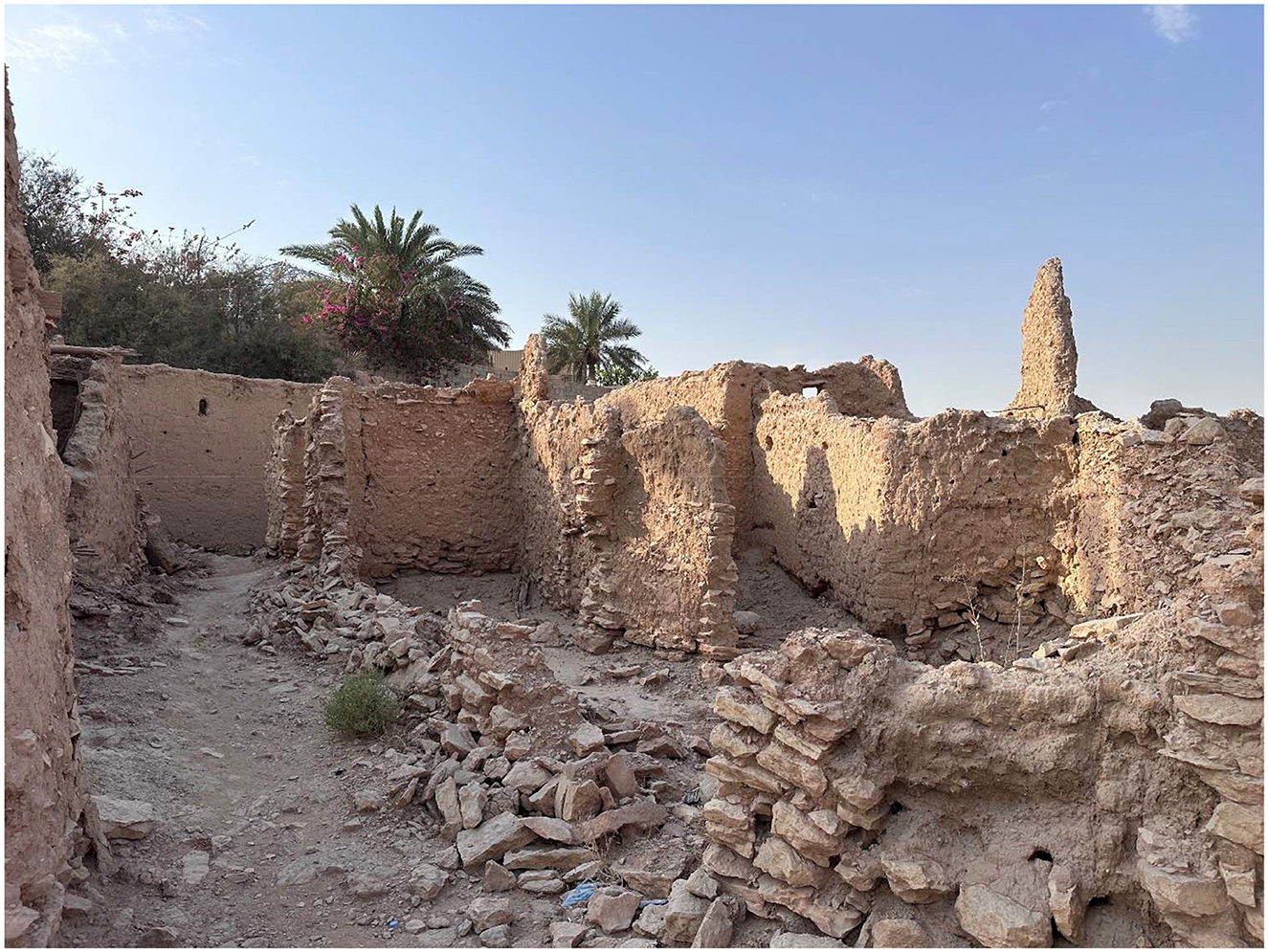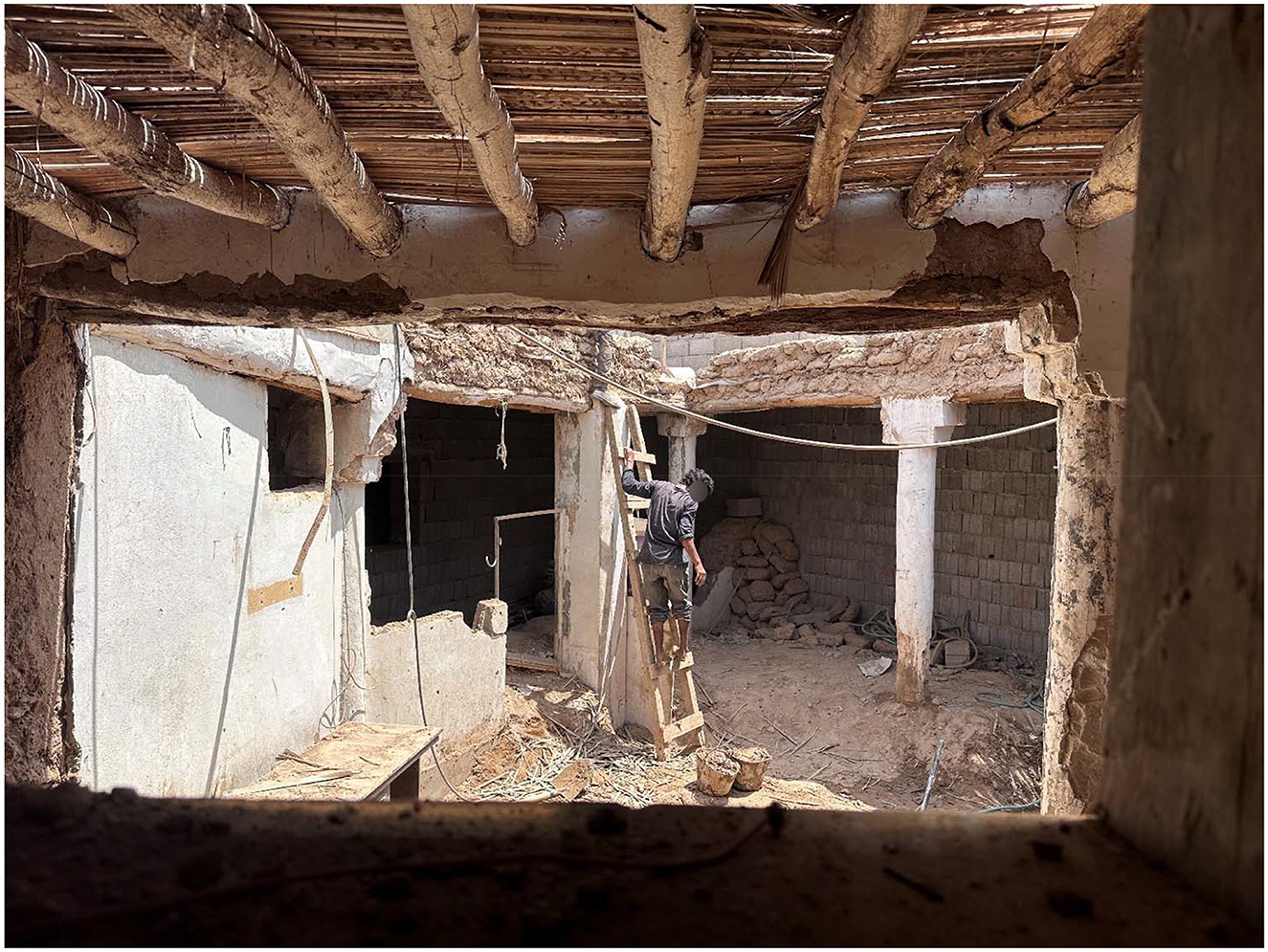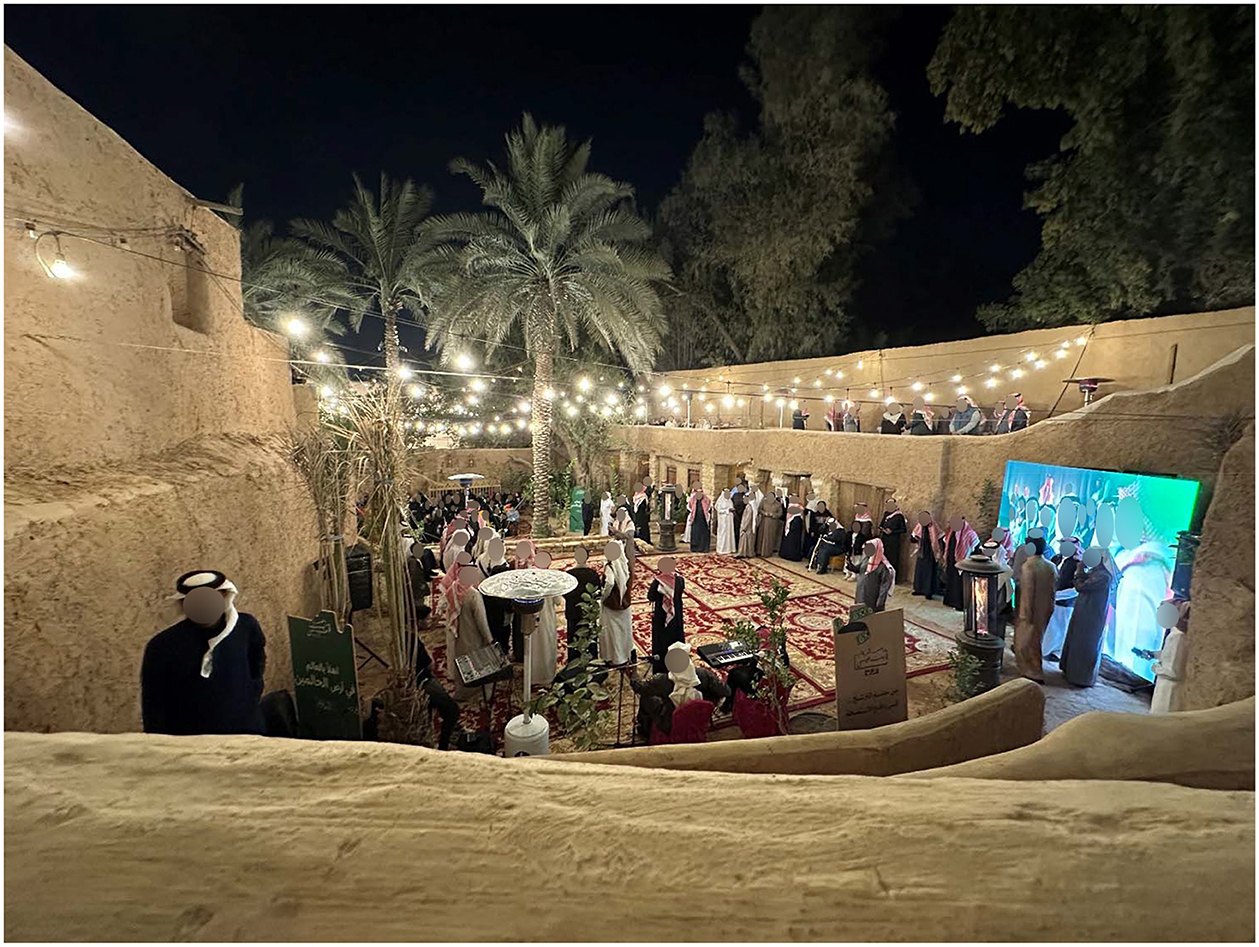- Department of Architecture and Interior Design, Lebanese American University, Beirut, Lebanon
This paper investigates the multifaceted role of mud in heritage preservation, focusing on the Bayt Isa restoration project in old Irqah within Wadi Hanifa, a site rich in historical significance in the Kingdom of Saudi Arabia. It aims at investigating the importance of mud beyond its geophysical properties, examining it as a semiotic material imbued with cultural meaning, sensorial qualities, and traditional communal practices. Furthermore, departing from a private restoration initiative, it is looking to learn from endeavors unbound by conventional building regulations and that could inform heritage preservation projects in Saudi Arabia and elsewhere in the world. To explore the role of mud in heritage preservation, the research relies on a literature review and a case study approach. The literature review identifies research emphasizing the cultural and sensory significance of mud in fostering social cohesion and collective identity. Furthermore, the case study of the Bayt Isa restoration in Wadi Hanifa examines mud as a dynamic material, bridging historical narratives and community values through qualitative research methods, including interviews with stakeholders, artisans, and visitors. Through an exploration of the semiotics of mud, this -research highlights its cultural and symbolic dimensions, revealing how mud embodies a lifestyle that fosters a deep sense of place and experience. The sensorial qualities of mud architecture—its tactile warmth and aesthetic appeal—forge emotional connections within the community, enhancing the lived experience of its inhabitants. Additionally, the paper underscores the importance of community engagement in mud construction, where local participation not only revitalizes traditional practices but also strengthens social bonds. Ultimately, this research advocates for heritage preservation approaches that transcend the mere conservation of traditional construction techniques. It posits that mud represents a vital process of cultural continuity and community development. Recognizing mud as more than a mere building material, we emphasize the need for a supportive framework that encourages private initiatives in mud heritage preservation. Such a framework should ensure that preservation efforts are context-specific, genuine and not diluted by popular demand or commercial interests, thereby safeguarding the rich, living environment that mud provides.
1 Introduction
In an era marked by growing environmental consciousness, local traditional construction materials are being revisited as sustainable alternatives with low ecological footprint and resilience to environmental hazards. Mud holds a prominent place, having been historically widespread and constituted an integral part of the landscapes of the East, even more those of Arab cities (AlSuliman, 2016). Al-Diriyah, a UNESCO World Heritage site in the Kingdom of Saudi Arabia, is one of those regions where building was mud-based until two or three decades ago (Ibid). As part of its vision 2030, the Kingdom has embarked on development plans in this region, envisioning the creation of a new “mud city” (Bin Ayyaf Almogren, 2022). Through this initiative, it aims to achieve sustainable growth by promoting local traditions and raising awareness on heritage and cultural values embedded in those practices (Mazzetto, 2023).
Building on this recent resurgence of interest in handmade buildings and the use of local materials in contemporary construction, recent research on mud has primarily focused on re-examining its mechanical and geological properties, as well as its potential to contribute to sustainable architecture (Lekshmi et al., 2016; Benghida, 2016; AlSuliman and Suliman, 2016; Abdulaziz Al-Jadeed, 2019; Ibrahim, 2021).
AlSuliman and Suliman (2016) investigate the structural and thermal properties of mud, presenting it as a viable material for modern construction when combined with innovative techniques. Environmental benefits of mud construction were approached by Lekshmi et al. (2016) who emphasize the material's adaptability to local climatic conditions and its potential for reducing the carbon footprint in the built environment. Beyond these practical applications, recent studies have increasingly revisited mud as a medium imbued with cultural and social significance. Benghida (2016) approaches it as a cultural medium, highlighting its role in reflecting the identity and traditions of communities in North Africa, while advocating for its integration into contemporary architectural practices. Similarly, Abdulaziz Al-Jadeed (2019) focuses on mud's capacity to convey historical narratives, demonstrating how its use in restoration projects preserves cultural authenticity and strengthens communal ties. Ibrahim (2021) further extends this perspective, delving into the sensory and experiential dimensions of mud, examining its tactile and aesthetic qualities as essential elements in fostering a sense of place and continuity.
Despite this growing body of research, a significant gap remains in exploring local materials like mud as carriers of local knowledge and culture. Addressing this gap forms the raison- d'être of our paper which explores mud not merely as a construction material but as what we term, a dynamic living material. This designation stems not only from its earthly composition, but also from its profound cultural significance. Mud embodies local traditions, recounts the history and evolution of local landscapes, and fosters engagement with community in multifaceted ways.
The article is structured into two primary components. First, it presents a literature review that underscores the significance of mud as a culturally engaging material. More critically, it introduces a case study: that of Bayt Isa, a private restoration project in Irqah, west of Riyadh. This case study not only exemplifies the practical application of mud in contemporary contexts but more importantly serves as a central argument supporting our hypothesis.
The Bayt Isa restoration project in old Irqah stands as a compelling case study that embodies the principles of culturally rooted heritage preservation, while innovatively blending mud with modern materials to create heritage houses that capture the essence of Najdi architecture and local culture. Notably at a time when heritage preservation projects are predominantly driven by public stakeholders, the Bayt Isa project highlights the vital role private initiatives can play in this domain. Engaging the private sector not only provides financial resources but also cultivates a sense of ownership and responsibility among community members. As Khalili (1991) emphasizes, these partnerships are crucial for ensuring that preservation efforts are sustainable and deeply rooted in local values, rather than driven by purely commercial motives or superficial trends.
2 Methodology
The methodology for this research comprised a literature review and a case study approach to represent the multifaceted role of mud in heritage preservation. The literature review aimed to identify existing frameworks and best practices in architectural heritage preservation, with a particular emphasis on the local significance of materials. This review underscored how locality influences preservation projects, highlighting the unique sensorial qualities of mud—its tactile warmth, aesthetic appeal, and cultural resonance—as integral to the lived experiences of communities. By focusing on the communal dimensions of mud construction, the review aims at highlighting how traditional practices can foster social cohesion and a collective identity, thereby enhancing community engagement in preservation efforts.
The case study of the Bayt Isa restoration project in old Irqah within Wadi Hanifa serves as a pivotal component of the methodology, offering an in-depth exploration of mud as more than a mere construction material. This case study facilitated an examination of mud's role as a living material, capable of conveying rich narratives about the historical and cultural context of the site. Through qualitative methods, including interviews with local stakeholders and artisans, the research captured the stories and experiences of both historical inhabitants and current residents, illustrating how mud construction practices bridge generational gaps and revive traditional habits. Such qualitative insights attempt to reinforce the notion that mud embodies a vital process of cultural continuity.
Data for this research was gathered through a combination of qualitative methods aimed at capturing diverse perspectives surrounding the Bayt Isa restoration project. Interviews were conducted with property owners, local stakeholders, and artisans to gain in-depth insights into their experiences and the significance of mud construction within their community. Additionally, interviews with visitors and analyses of comments on social media platforms provided a broader context, revealing public perceptions and engagement with the restoration efforts. This multifaceted approach to data collection not only enriched the understanding of the communal narrative surrounding mud as a heritage material but also allowed for comparative analysis. Recurring motifs and sentiments, highlighting the interconnectedness of community identity, cultural continuity, and the role of mud in heritage preservation were identified. By triangulating these various sources of information, the study aims to provide a comprehensive understanding of how mud serves as a dynamic medium that reflects both historical narratives and contemporary community values.
By integrating these methodologies, the study advocates for a paradigm shift in heritage preservation positioning mud not only as a construction material but as a dynamic medium that encapsulates the essence of community life. This approach advocates for the development of supportive frameworks that empower local initiatives, ensuring that preservation efforts remain authentic and reflective of the community's values, thereby safeguarding the rich, living heritage that mud represents. This approach provides a nuanced understanding of the interplay between materiality, community engagement, and cultural identity, reinforcing the imperative for context-sensitive preservation strategies.
3 The significance of mud in cultural heritage and sustainability
Mud as a construction material offers significant environmental benefits and plays a crucial role in heritage preservation, especially in regions where traditional techniques are integral to cultural identity (Fernandez et al., 2019). While it is often viewed through the lens of its geo-technical properties, its sociocultural attributes are vital for supporting local cultural continuity. However, traditional mud construction faces risks from modern environmental stresses, such as increased rainfall and temperature fluctuations, which threaten its durability (Chen et al., 2025). Although specialized practices can enhance the longevity and resistance of mud (Lopez-Rebollo et al., 2024), our study will focus on its cultural significance rather than these technical aspects.
Prominent scholars, such as Hassan Fathy, have championed the use of mud in architecture, emphasizing its benefits for environmental sustainability and cultural continuity. In his seminal work, Architecture for the Poor, Fathy (1973) argues for mud construction as a means of providing affordable housing while respecting local traditions and materials. His philosophy underscores the importance of integrating architectural practices with the socio-cultural contexts of the communities they serve.
While the traditional techniques of mud construction are integral to the heritage they represent, they may not always be overtly visible in the finished structures. This nuance invites a broader understanding of mud architecture. it is not solely the explicit craftsmanship that defines its significance, but rather the underlying cultural narratives and communal practices that these buildings encapsulate. As a local material, mud encapsulates a wealth of cultural, historical, and social dimensions that inform our understanding of community identity and heritage. This literature review aims to explore the multifaceted qualities of mud, emphasizing its semiotic, sensorial, and community engagement attributes. These characteristics not only illustrate its role as a construction material but also highlight its cultural relevance in heritage preservation projects.
4 Mud, more than a construction material, mud as a living material
4.1 Mud as a signifier of cultural continuity and local identity
The use of mud as a building material transcends its physical properties, embodying meanings that resonate within local communities. Mud architecture serves as a powerful medium for expressing cultural identity and narratives, acting as a signifier of continuity and local identity. Its aesthetic qualities and traditional building techniques evoke a sense of place connected to community history. Mud structures symbolize resilience and continuity, reflecting local practices and ancestral ways of life (AlSuliman, 2016). In Arab cities, mud communicates values of sustainability and harmony with nature (AlSuliman and Suliman, 2016). This material showcases how local resources shape cultural expression; in regions like Morocco and Yemen, mud buildings serve as repositories of collective memory.
Umberto Eco's exploration of semiotics emphasizes that signs and symbols are integral to culture, influencing how individuals perceive their environment (Eco, 1976). In mud architecture, the material signifies cultural identity, representing both physical presence and a narrative of belonging. The revival of mud construction techniques counters globalization, which often dilutes local identities (Mazzetto, 2023). By embracing mud, communities reaffirm their heritage while adapting to modern needs, illustrating how mud architecture can symbolize cultural identity and a commitment to sustainability.
The semiotics of mud architecture reveal connections between material culture, identity, and community, reflecting the values and stories of those who inhabit these structures. Each mud building tells a story of its inhabitants' values, struggles, and aspirations, creating a rich tapestry of cultural heritage. As communities face modernization and environmental change, the significance of mud architecture as a vessel of cultural identity becomes increasingly vital, reinforcing the need for its preservation and appreciation.
4.2 A sensory examination of mud architecture
Mud's sensorial qualities contribute significantly to the atmosphere and spatial experience of built environments. The tactile warmth, malleability, and aesthetic appeal of mud create immersive spaces that resonate with inhabitants and visitors alike. These qualities can shape the physical environment, influencing how spaces are perceived and utilized (Lekshmi et al., 2016). In regions such as Morocco and Yemen, mud construction exemplifies the adaptability and resilience of traditional mud building. In Morocco, the earthen architecture of the medinas and kasbahs showcases the sensorial qualities of mud, which allows the spaces to have balanced temperature and humidity, making them suitable for the local climate (El Rharbi and Jarrad, 2014). The process of applying and working with mud—whether through plastering walls or sculpting forms—also engages the senses in a participatory manner. This hands-on interaction allows individuals to connect with the material on a personal level, enhancing their relationship with space. Architect Hassan Fathy highlights the importance of manual skills in building with earth, noting that the act of creating with mud fosters pride and ownership among artisans and residents (Fathy, 1986).
Mud architecture engages the senses in unique and profound ways. The tactile qualities of mud—its texture, temperature, and form—invite interaction and create a visceral connection between inhabitants and their environment. Architect Nader Khalili emphasizes that the use of natural materials like mud fosters a deeper engagement with the built environment, allowing individuals to experience spaces not just visually but also through touch (Khalili, 1991). The texture of mud, often characterized by its softness and warmth, evokes a sensory response distinct from more rigid materials. When touched, mud can feel cool in warm climates and warm in cooler conditions, effectively regulating the microclimate of a space. This sensory interaction aligns with the ideas of Perez-Gomez, who notes that materials possess the power to evoke emotional responses and create a sense of place (Perez-Gomez, 2006). The physicality of mud invites users to engage in tactile exploration, fostering comfort and intimacy within space.
Visually, mud architecture presents a rich palette of colors and forms that vary dramatically based on local soil types and construction techniques. The organic hues of mud ground inhabitants in their environment, evoking feelings of connection to the earth. Juhani Pallasmaa, in his exploration of sensory architecture, argues that the visual and tactile experiences of materials significantly contribute to the perception of space and atmosphere (Pallasmaa, 2005). Mud's natural variations in texture and color can trigger memories and associations, creating a multi-layered experience that resonates with users.
Recent preservation efforts, such as those in Al Ula, Saudi Arabia (Figure 1), illustrate the significance of these sensory qualities. The Al Ula Heritage Project aims to restore the region's historical mud structures, emphasizing the sensory experiences they provide. By revitalizing mud architecture, the project seeks to engage visitors' senses, allowing them to appreciate the tactile warmth and visual richness of the material.
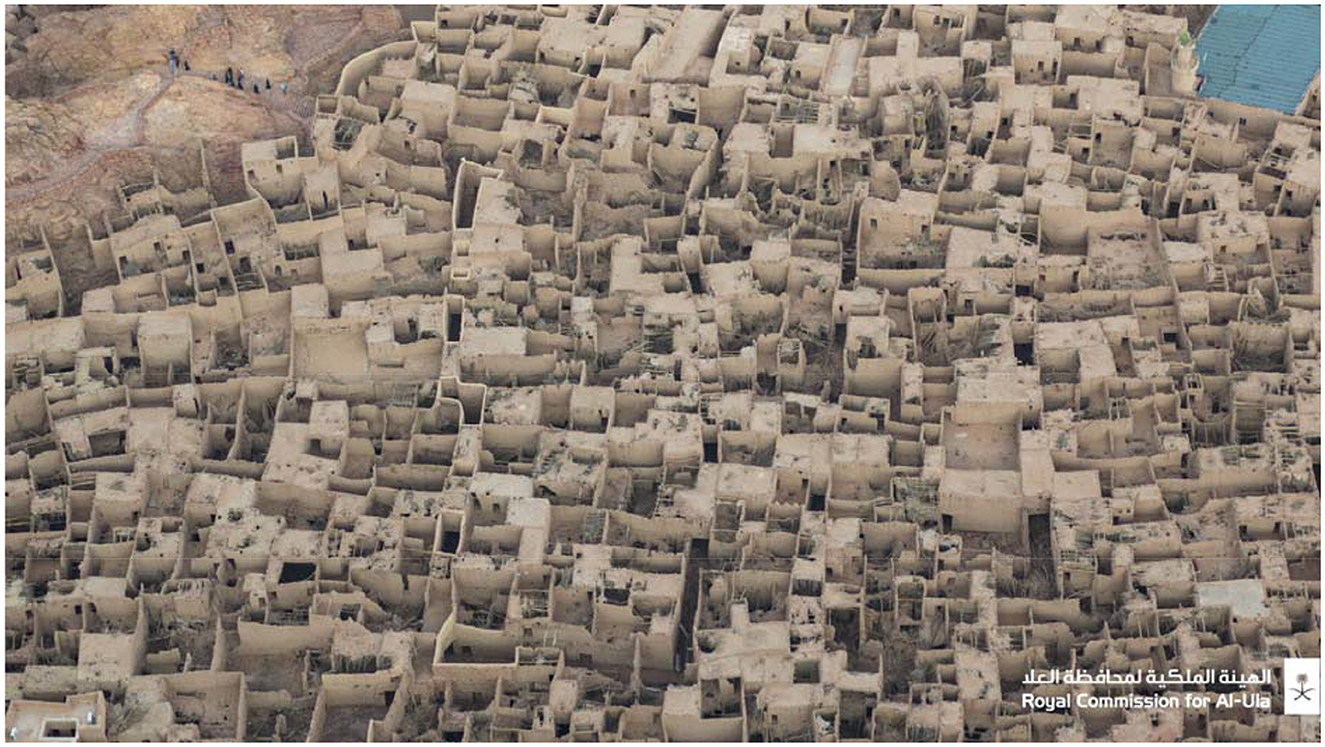
Figure 1. The old Al Ula town in Medina, The Kingdom of Saudi Arabia. Source: Royal Commission for AlUla (2024).
Additionally, the acoustic properties of mud contribute to the sensory atmosphere of a space. The thick walls of mud structures can absorb sound, creating a calm and peaceful environment that enhances the overall sensory experience. This acoustic quality is particularly relevant in communal settings, where the interaction of voices and sounds can be softened, promoting and reproducing the tranquility and intimacy of old mud settlements.
The sensorial experience of mud architecture encompasses a rich interplay of touch, sight, and sound that deepens the connection between inhabitants and their environment. The sensory experiences invite interaction, encouraging occupants to engage with their surroundings in meaningful ways evoking feelings of nostalgia and connection to the locale (Benghida, 2016). The interplay of sensory experiences reinforces the notion that mud is not merely a construction material; it is essential in shaping the lived experience of communities.
4.3 Mud and community: the collaborative process of constructing with earth
The concept of habitus elucidates the relationship between architecture and identity, suggesting that the physical environment reflects the social practices and cultural values of a community (Bourdieu, 1990). Mud architecture, with its communal construction processes and local material use, embodies the collective identity of the community. It manifests the social structures, rituals, and shared experiences that reinforce bonds among community members. The act of building with mud often involves collective participation, fostering a sense of belonging and shared identity.
In fact, the Engagement with mud transcends its physical use; it embodies practices and traditions that have evolved over generations. The communal activities surrounding mud construction—such as gathering materials, crafting, and building—foster collaboration and social bonds within communities (Ibrahim, 2021). These practices are not only integral to the construction process but also serve as opportunities for cultural transmission and skill development. The engagement with local materials like mud emphasizes the importance of local knowledge and craftsmanship, reinforcing a sense of ownership and pride among community members (Abdulaziz Al-Jadeed, 2019). As communities actively participate in the preservation and innovation of mud-based architecture, they strengthen their connection to the land and landscape, ensuring that heritage values endure through contemporary practices.
Mud, as a building material, is often described as a “living” substance due to its dynamic properties and the ongoing relationship it establishes with its environment and inhabitants. Unlike static materials such as concrete or steel, mud structures require community involvement before the construction starts and is continues afterwards, requiring regular maintenance and care and reflecting their organic nature. This necessity for upkeep is not merely a chore but an integral part of the life cycle of mud architecture, allowing it to evolve and adapt over time.
Mud brick structures in Yemen, particularly in the old city of Sana'a, exemplify the intricate craftsmanship and communal practices associated with this building material (Abdul Hamid et al., 2023). These areas reflect the historical significance of mud construction techniques while also demonstrating community engagement and understanding of local materials, which have shaped their identity and supported continuity and sustainability. This relationship between mud architecture and its inhabitants is further illustrated by the tall mud-brick towers of Shibam (Figure 2), which require continuous maintenance. Local craftsmen employ traditional techniques to preserve these structures, reinforcing cultural identity and community ties, as noted by Fathy (1986). Such maintenance practices are woven into the social fabric, highlighting the dynamic connection between the community and its architectural heritage.
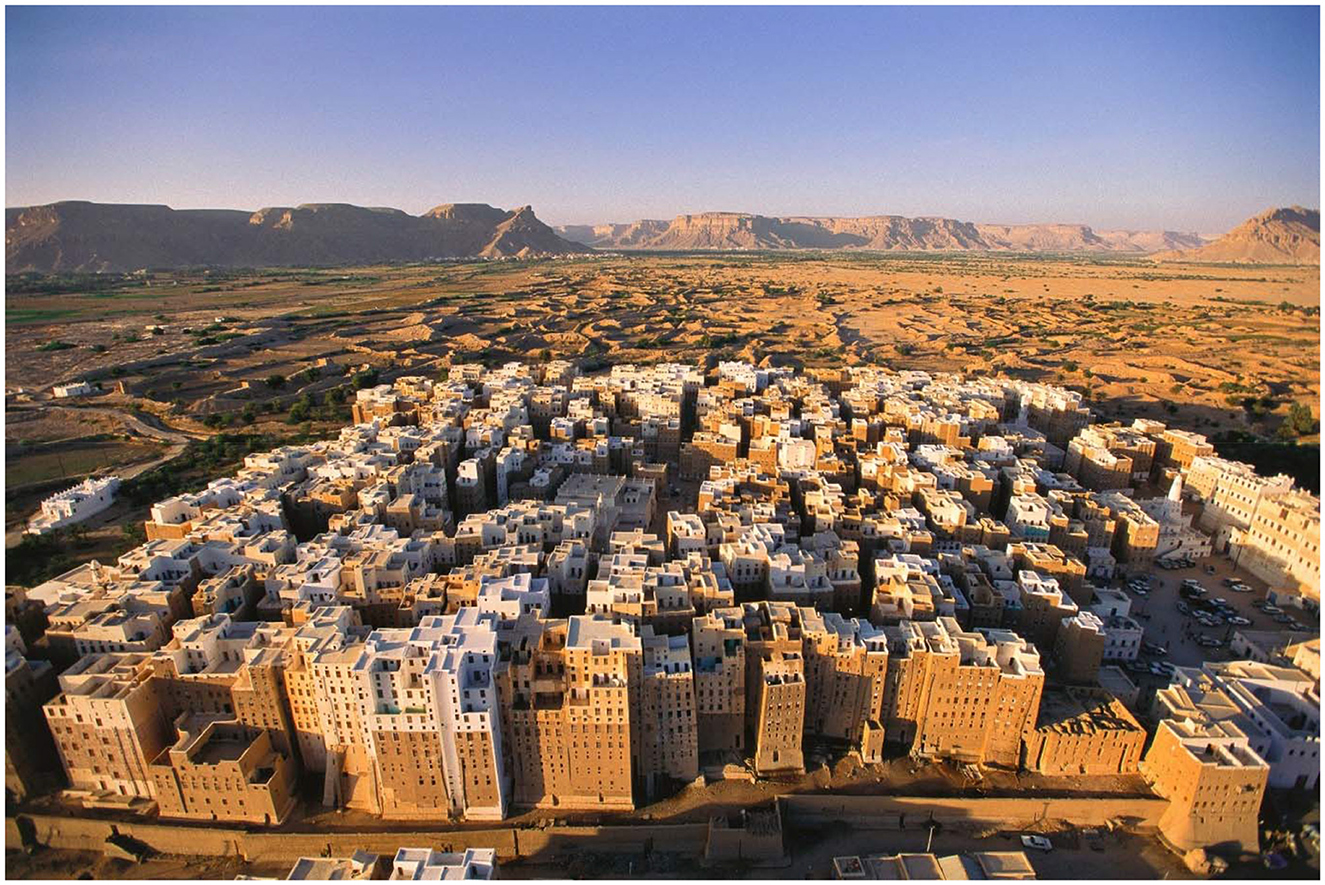
Figure 2. Yemen's old walled city of Shibam, a cluster of mud skycrapers. Source: Khan (2017).
Similarly, the Djenne Mosque in Mali undergoes annual re-plastering, a communal tradition that highlights the mosque's resilience and the importance of collective care in sustaining cultural heritage (Khalid, 2023). Such practices transform maintenance into a cultural event, strengthening social bonds and emphasizing the mosque's role as a living monument. This reflects the views of Khalid (2023), who argue that the maintenance of earthen structures is essential for preserving their cultural significance and fostering community engagement.
In contemporary contexts, projects like the Desert Nights Camp in Oman invite guests to participate in upkeep activities, such as re-plastering walls, fostering a sense of stewardship and connection to the environment. This collaborative approach emphasizes that the building is a dynamic structure that evolves with its users (Ebeh et al., 2024). The earth architecture project in France integrates community engagement through workshops that teach residents to maintain their mud homes, thus enhancing social ties and creating a living network of support around the structures (Perez-Gomez, 2006). This notion is further supported by the work of Ebeh et al. (2024), which discusses how participatory methods in construction can lead to greater ownership and sustainability.
In summary, mud emerges as a vital local material that encapsulates cultural, historical, and social dimensions, offering insights into community identity and sustainable practices. Its semiotic, sensorial, and engagement qualities illuminate how mud not only serves as a construction resource but also as a medium for cultural expression and continuity. The exploration of mud as a dynamic living material allows us to learn lessons from the past and encourages the continuation of traditional practices in a sustainable manner, thanks to its local availability. This literature review sets the stage for a deeper discussion of the Bayt Isa restoration project, which exemplifies the practical application of these concepts in a contemporary context, as detailed in the following sections.
5 Emerging private sector initiatives in heritage preservation
In recent years, there has been a significant rise in private-sector involvement in heritage preservation projects across Saudi Arabia. While government initiatives have historically led the way, many private entities are now actively engaging in restoring cultural heritage, particularly focusing on traditional mud architecture. Projects like the Al-Balad Restoration Project in Jeddah and collaborations in the Al-Ula Heritage Project exemplify efforts to revitalize historic areas, emphasizing sustainable practices and local craftsmanship.
In addition to these broader initiatives, a growing number of individual property owners are taking the lead in self-financing restoration efforts for their inherited properties. These owners are deeply invested in transforming their family heritage sites into spaces that narrate stories about their ancestors and the local community. For example, in Jeddah, many families are restoring their traditional mud houses, ensuring that the architectural integrity is preserved while also highlighting the cultural significance of their family histories. This grassroots approach not only maintains the physical fabric of these buildings but also reinforces the emotional and cultural connections between the community and its heritage.
6 Case study: Bayt Isa in Irqah, KSA
The Bayt Isa project represents an important case study in heritage preservation within the town of Irqah, situated northwest of Riyadh, Saudi Arabia. This initiative exemplifies the intersection of cultural conservation, community engagement, and sustainable architectural practices. Historically, Irqah, located near Wadi Hanifa, featured traditional mud houses that have succumbed to the ravages of time. Wadi Hanifa, an important geographical feature, has traditionally supplied construction materials. Its palm groves provided fronds used for roofing, highlighting their role in the area's architectural heritage (Figures 3, 4).
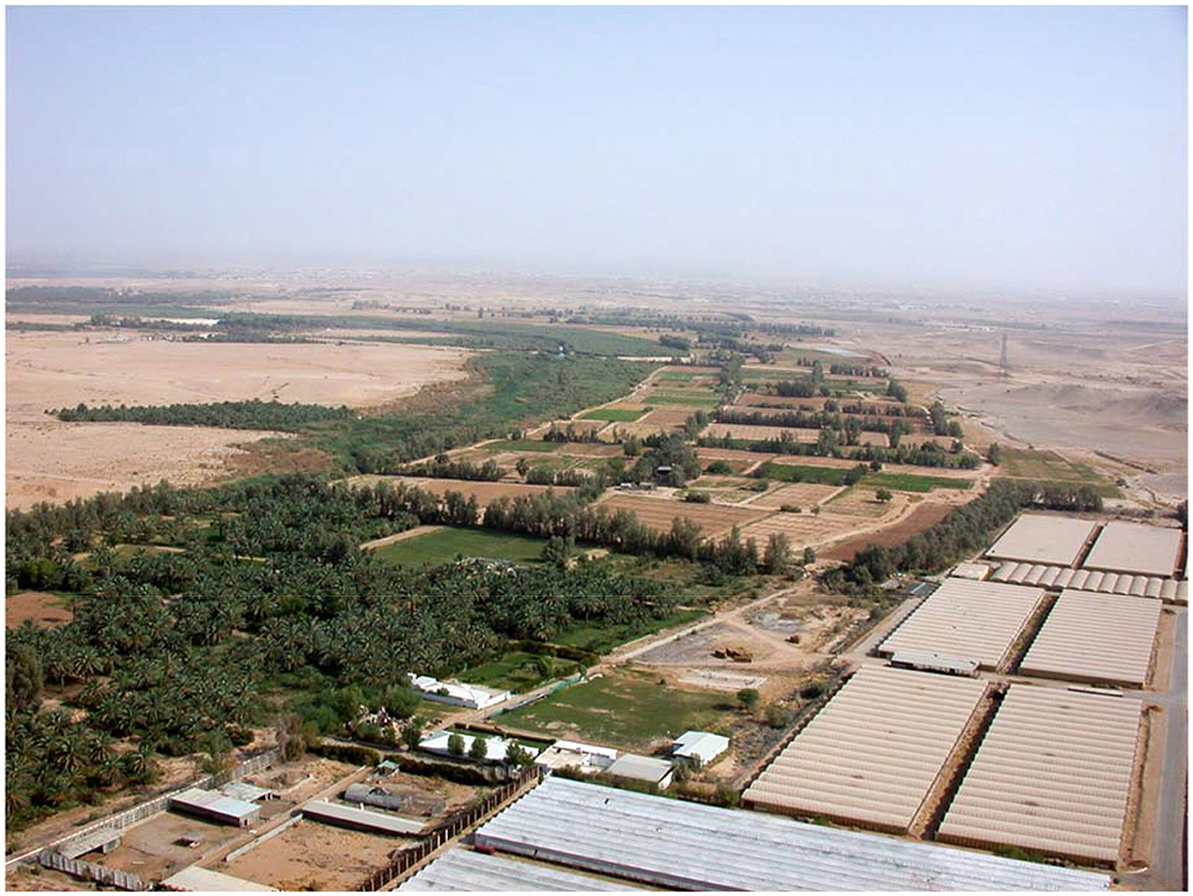
Figure 3. Aerial view of the Wadi Hanifa wetlands that provided resources for local construction and restoration projects. Source: Samhouri and AKAA (2009).
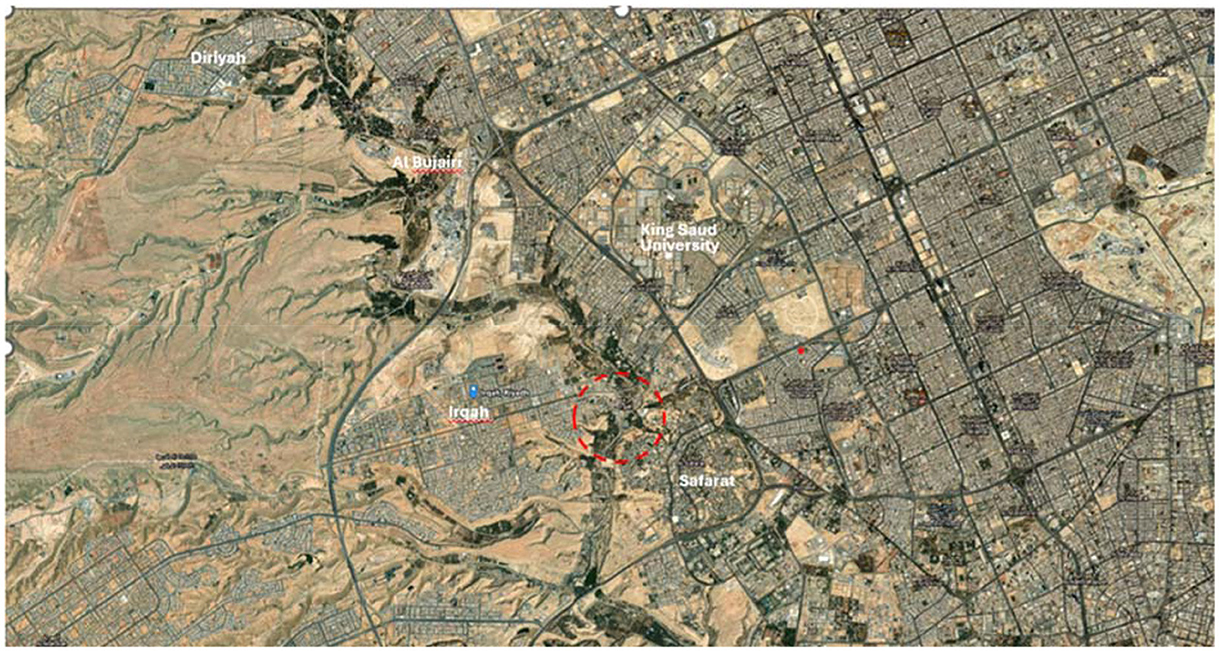
Figure 4. Satellite image showing, in red, the location of Bader's Heritage Preservation Project. Source: ARCGIS Earth (2022).
The analytical framework for evaluating the Bayt Isa heritage renovation project is grounded in the principles of heritage conservation and participatory development, focusing on three primary metrics: cultural preservation, community engagement, and sustainability. These metrics assess the project's success in revitalizing traditional architecture, fostering community involvement, and promoting environmentally responsible practices. A key criterion within this framework is the flow of locals visiting and engaging with the site, serving as an indicator of its cultural relevance, social impact, and ability to attract and entertain the community.
Cultural preservation is evaluated based on how effectively the project maintains and restores traditional Najdi architecture and construction techniques, such as the use of mud, stone, and palm fronds (Figures 5, 6). The framework examines whether the restoration respects the historical and cultural integrity of the area, ensuring that the heritage value of the site is preserved for future generations. Community engagement assesses the level of local involvement in the project, from decision-making processes to active participation in restoration activities, considering whether the project has fostered a sense of ownership and pride among community members and strengthened social cohesion by reviving traditional gathering spaces like courtyards. Sustainability analyzes the use of locally sourced and recycled materials, such as stones from Wadi Hanifa and palm fronds for roofing, while also evaluating the long-term environmental impact of the restoration and alignment with sustainable development principles.
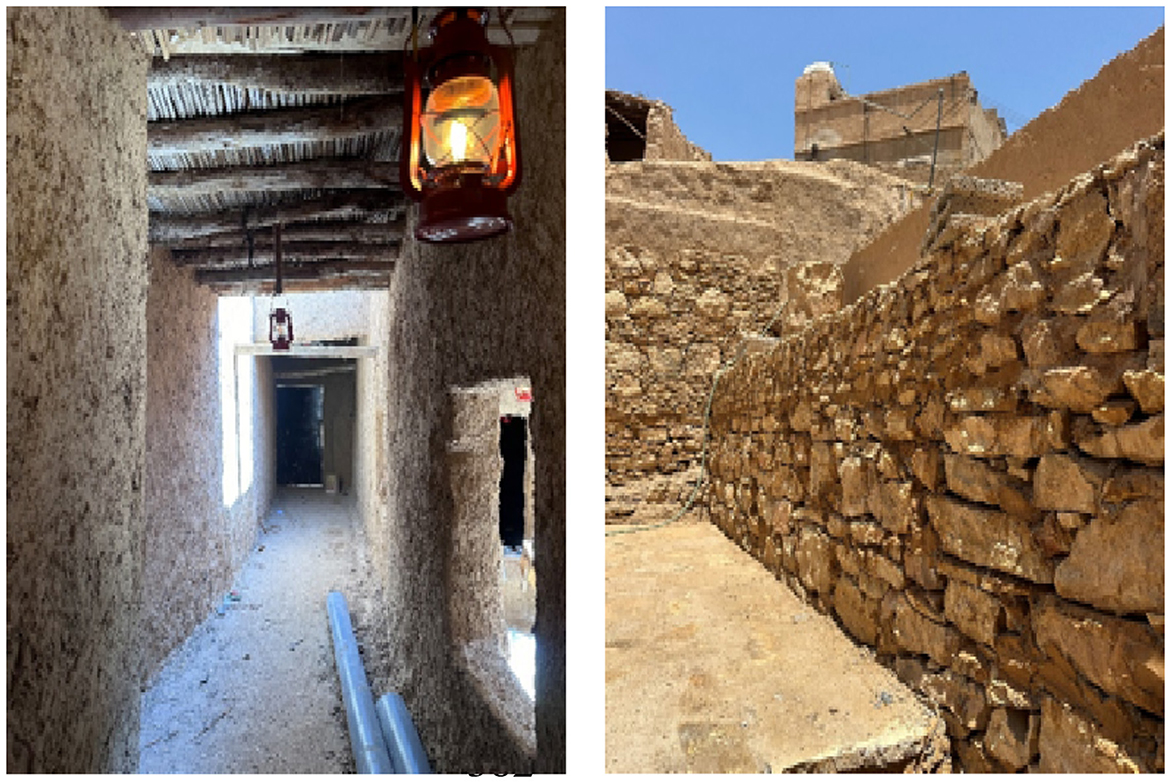
Figure 6. Wall restoration using local recycled stones and palm fronds from Wadi Hanifa. Source: photos David Aouad, 2023.
The data collection process for the Bayt Isa heritage renovation project primarily involved extensive site visits throughout the construction phase, allowing for direct observation of the restoration process. Informal interviews with Bader (the owner and initiator of the project), community members, and artisans provided rich, context-specific insights (Figure 7). These conversations highlighted Bader's deep personal commitment to preserving his family's heritage and his vision for transforming the area into a cultural and touristic hub. Additionally, discussions with local artisans (Figure 8) emphasized their pride in contributing to the project and their appreciation for the revival of traditional practices. However, it is important to note that no formal surveys were conducted to gauge broader community satisfaction, which limits the ability to quantify the project's social impact.
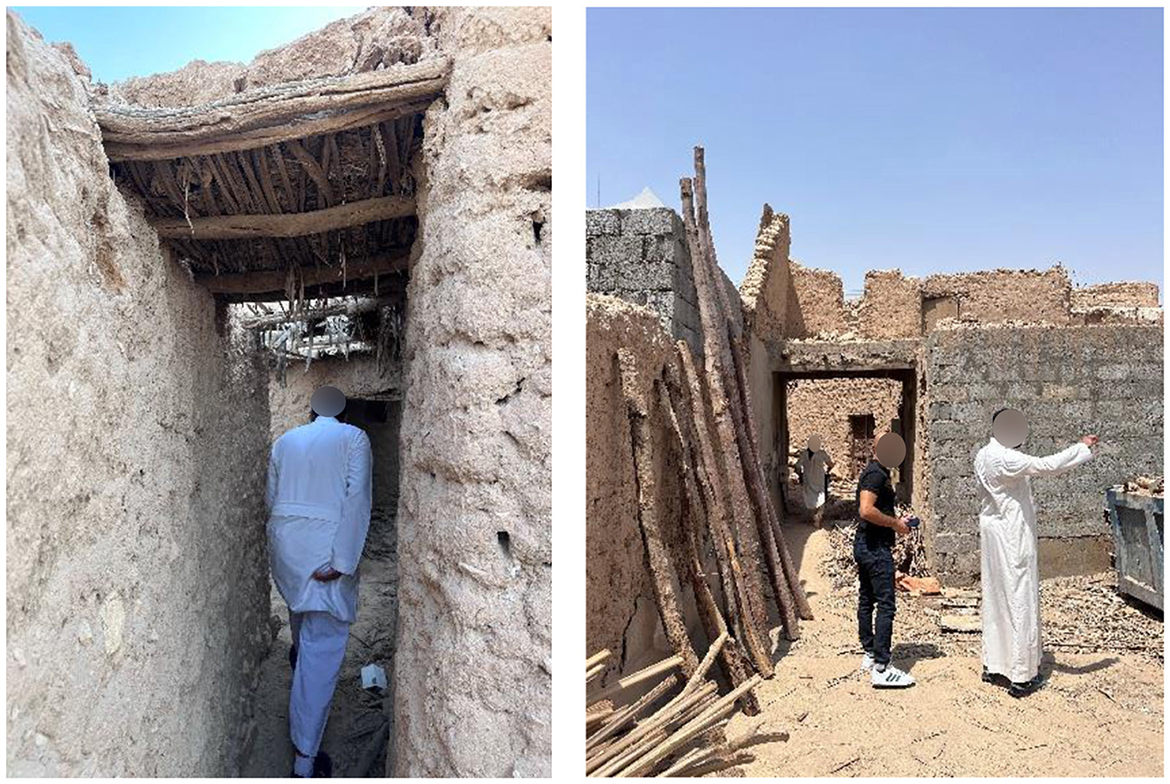
Figure 7. Informal talks with Bader (the owner and initiator of the project). Source: photos David Aouad, 2023.
To contextualize the Bayt Isa project within the broader landscape of heritage restoration in Saudi Arabia, a comparative analysis was conducted with other notable projects, such as the Diriyah restoration project. The Diriyah project, led by national institutions, focuses on large-scale urban heritage revival. In parallel, Bayt Isa offers a grassroots, community-led model that highlights how private initiatives can complement broader national strategies in heritage conservation. The adopted participatory model in the Bayt Isa restoration project not only preserved the authenticity of the area but also fostered a sense of ownership and pride among community members, which is often absent in more rigid, top-down projects. Bayt Isa demonstrates the potential of community-based approaches within a diverse heritage ecosystem.
Quantitatively, the Bayt Isa project successfully restored approximately 18 houses, transforming them into vibrant spaces reflecting traditional Najdi architectural style (Figure 8). Remarkably, almost all materials were recycled, including stones from Wadi Hanifa and palm fronds for roofing, aligning the project with sustainable practices and minimizing waste. The project's influence on local tourism is evident through events hosted on official holidays and weekends, attracting visitors from across the region. These events, which include cultural performances, art exhibitions, and educational activities, have created a dynamic cultural hub that celebrates the area's heritage.
Qualitatively, the project has revitalized the community's connection to its cultural roots. By restoring traditional courtyards and gathering spaces (Figures 9, 10), Bayt Isa has rekindled a sense of communal identity and pride. The involvement of local artisans and the use of traditional construction techniques ensured that the restoration process became a means of cultural transmission, passing down skills and knowledge to younger generations. The restoration process grew through a spirit of collaboration between Bader and the local community. His deep commitment to cultural preservation resonated with residents, inspiring shared ownership of the project and strengthening bonds around a common vision for reviving their heritage. This collective engagement became central to the project's success.
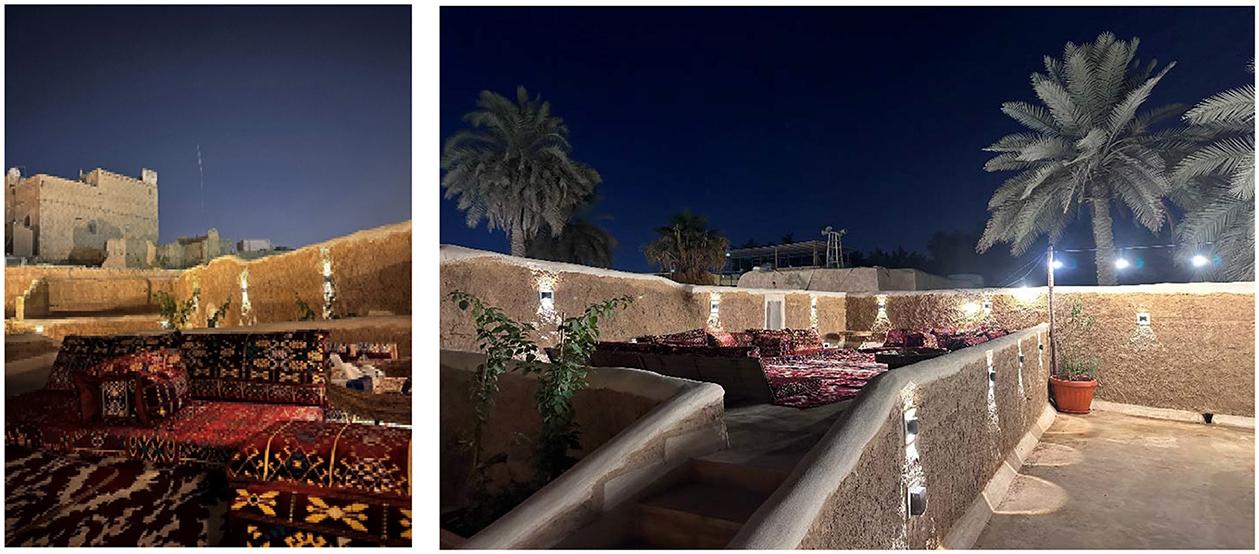
Figure 9. Rooftop courtyard and seating that evoke the traditional Saudi way of life. Source: photos David Aouad, 2023.
The Bayt Isa project also contributes significantly to broader cultural preservation efforts in Saudi Arabia, particularly within the context of the Kingdom's Vision 2030, which emphasizes cultural heritage as a pillar of national identity and economic diversification. By restoring traditional Najdi architecture and reviving local building techniques, Bayt Isa serves as a model for preserving Saudi Arabia's rich cultural heritage amid rapid modernization. The project demonstrates how grassroots initiatives can complement government-led efforts, fostering community ownership and engagement, unlike the top-down approach seen in projects like Diriyah.
Key lessons from Bayt Isa include the importance of community engagement, flexibility in addressing challenges, and sustainability through local resources. Such principles can be replicated or adapted in other contexts by encouraging community-driven models, integrating modern and traditional practices, incorporating cultural programming, and forming partnerships with local stakeholders. By embracing these principles, other heritage restoration projects can replicate Bayt Isa's success, contributing to the preservation of cultural heritage while fostering community development and sustainable tourism.
7 Concluding remarks
In conclusion, mud is more than just a local building material; it is a living material that encapsulates a dynamic process of cultural engagement, community participation, and sustainable development. The restoration project of Bayt Isa in Irqah exemplifies how mud architecture can act as a catalyst for heritage preservation while simultaneously fostering economic growth and social cohesion. By actively involving communities in construction and preservation, it is possible to transcend the material properties of mud, nurture a sense of ownership, and facilitate a reconnection with cultural narratives—ultimately preserving the collective identity.
As the Kingdom of Saudi Arabia advances toward achieving its Vision 2030 objectives, embracing mud as a process rather than merely a material opens the door to innovative approaches in urban planning and heritage conservation. This perspective is deeply rooted in local culture, respecting traditional heritage while encouraging a diversity of architectural expressions that avoid imposing a uniform style or material. Building on this, we advocate for the integration of private heritage preservation initiatives as vital, context-specific endeavors that serve as carriers of local cultures. However, these initiatives must operate under the guidance of dedicated commissions tasked with regulating their implementation and ensuring compliance with applicable laws.
More broadly, we advocate for a paradigm shift in heritage preservation positioning mud not only as a structural element but as a dynamic medium that encapsulates the essence of community life. We believe that this is a transformative approach. This transformative approach to heritage preservation recognizes the intrinsic value of both tangible and intangible heritage, ensuring that the essence of community life is honored alongside physical structures. By re-examining mud not just as a material, but as a dynamic medium, we open avenues for sustainable practices that transcend outdated techniques. This perspective encourages innovation and resilience, allowing communities to reinvest in their cultural landscapes while preserving their rich histories for future generations.
Data availability statement
The original contributions presented in the study are included in the article/supplementary material, further inquiries can be directed to the corresponding author/s.
Author contributions
RE-K: Writing – original draft, Writing – review & editing. DA: Writing – original draft, Writing – review & editing. CL: Writing – original draft, Writing – review & editing.
Funding
The author(s) declare that no financial support was received for the research and/or publication of this article.
Conflict of interest
The authors declare that the research was conducted in the absence of any commercial or financial relationships that could be construed as a potential conflict of interest.
Generative AI statement
The author(s) declare that no Generative AI was used in the creation of this manuscript.
Publisher's note
All claims expressed in this article are solely those of the authors and do not necessarily represent those of their affiliated organizations, or those of the publisher, the editors and the reviewers. Any product that may be evaluated in this article, or claim that may be made by its manufacturer, is not guaranteed or endorsed by the publisher.
References
Abdul Hamid, A., Ismail, M., and Abdullah, R. (2023). The Yemeni Architecture Influenced the Culture In the Tower House In Bab el Yemen. Int. J. Inn. Ind. Rev. 5, 184–196.
Abdulaziz Al-Jadeed, M. (2019). Mud is an Engineering Material Promising to Achieve the Principles of Sustainable Architecture. Al-Azhar Univ. Eng. Sect. 14, 781–799. doi: 10.21608/auej.2019.33703
AlSuliman, A. (2016). “The formation of the traditional mud architecture and sustainability in the twenty-first century,” in Conference: International Congress on Technology, Engineering and Science (ICONTES).
AlSuliman, A., and Suliman, L. (2016). Mud Architecture and the Prospects of Its Sustainability. Available online at: https://www.researchgate.net/publication/297032349_Mud_Architecture_and_the_Prospects_of_Its_Sustainability (accessed March 2016).
ARCGIS Earth. (2022). Satellite image of Al Dirriyah. ArcGis Online. Available online at: https://www.arcgis.com/index.html
Benghida, D. (2016). Earth architecture: An eco-compatible solution for future. Advances in Civil, Architectural, Structural and Constructional Engineering. Balkema: CRC Press
Bin Ayyaf Almogren, N. (2022). Mud City: Perceptions and Misconceptions of Diriyah. Cambridge: Harvard University Graduate School of Design.
Chen, Y., Saqib, M., Shahzada, K., Aizaz, M., and Gul, A. (2025). Assessment of mechanical properties and durability of compressed mud bricks stabilized with stone dust, wheat, straw, and cement. Sci. Rep. 15:1950.
Ebeh, C., Okwandu, A., Abdulwaheed, S., and Iwuanyanwu, O. (2024). Community engagement strategies for sustainable construction projects. Int. J. Eng. Res. Dev. 20, 367–373.
El Rharbi, S., and Jarrad, F. (2014). Earthen architecture & sustainable building: Proposed union between authenticity and technical renovation. WSB 14 Barcelona 493–499.
Fathy, H. (1973). Architecture for the Poor: An Experiment in Rural Egypt. Chicago: University of Chicago Press.
Fathy, H. (1986). Natural Energy and Vernacular Architecture: Principles and Examples with Reference to Hot Arid Climates. Chicago: University of Chicago Press.
Fernandez, J., Peixoto, M., Mateus, R., and Gervasio, H. (2019). Life cycle analysis of environmental impacts of earthen materials in the Portuguese context: Rammed earth and compressed earth blocks. J. Clean. Prod. 241:118286.
Ibrahim, A. (2021). The mud traditional architecture of the Sudan and Saudi Arabia: the difference in employment techniques. Eximia Sci. 3, 100–116.
Khalid, R. (2023). A typological study of West African Mosque at Djenne, Mali. Astrolabe 2023, 18–31.
Khan, G. (2017). This ancient mud scraper city is the “Manhattan of the Desert”. National Geographic. Available online at: https://www.nationalgeographic.com/travel/article/shibam-mud-skyscraper-yemen
Lekshmi, M. S., Vishnudas, S., and Nair, D. G. (2016). An investigation on the potential of mud as sustainable building material in the context of Kerala. Int. J. Energy Technol. Policy. 13, 107–122. doi: 10.1504/IJETP.2017.080621
Lopez-Rebollo, J., Cardenas-Haro, X., Parra-Vargas, J., Narvaez-Berrezueta, K., and Pino, J. (2024). Improvement of mechanical properties of compressed earth blocks with stabilising additives for self-build of sustainable housing. Buildings 14:664.
Mazzetto, S. (2023). Heritage conservation and reuses to promote sustainable growth. Mat. Today Proc. 85, 100–103. doi: 10.1016/j.matpr.2023.05.269
Perez-Gomez, A. (2006). Built upon Love: Architectural Longing and the Making of the Modern House. Cambridge: MIT Press.
Royal Commission for AlUla (2024). “New archaeological finds in Saudi Arabia's AlUla are filling in “missing links” in the history of the region”. Royal Commission for AlUla. Available online at: https://classic.rcu.gov.sa/en/media-gallery/news/new-archaeological-finds-in-saudi-arabia-s-alula-are-filling-in-missing-links-in-the-history-of-the-region/
Samhouri, W., and AKAA. (2009). Wadi Hanifa Wetlands. Aga Khan Award for Architecture. Available online at: https://the.akdn/en/how-we-work/our-agencies/aga-khan-trust-culture/akaa/wadi-hanifa-wetlands
Keywords: heritage preservation, mud architecture, Wadi Hanifa, cultural preservation, community engagement
Citation: El-Khoury R, Aouad D and Lteif C (2025) Beyond materiality: mud as a living material in heritage preservation. Front. Sustain. Cities 7:1550496. doi: 10.3389/frsc.2025.1550496
Received: 14 January 2025; Accepted: 31 March 2025;
Published: 28 April 2025.
Edited by:
Roberto Alonso González-Lezcano, CEU San Pablo University, SpainReviewed by:
Maria Concepcion Perez Gutierrez, CEU San Pablo University, SpainHala Sirror, Prince Sultan University, Saudi Arabia
Copyright © 2025 El-Khoury, Aouad and Lteif. This is an open-access article distributed under the terms of the Creative Commons Attribution License (CC BY). The use, distribution or reproduction in other forums is permitted, provided the original author(s) and the copyright owner(s) are credited and that the original publication in this journal is cited, in accordance with accepted academic practice. No use, distribution or reproduction is permitted which does not comply with these terms.
*Correspondence: Roula El-Khoury, cm91bGFrLmZheWFkQGdtYWlsLmNvbQ==; David Aouad, ZGF2aWQuYXdhZEBsYXUuZWR1Lmxi
 Roula El-Khoury
Roula El-Khoury David Aouad
David Aouad Carine Lteif
Carine Lteif